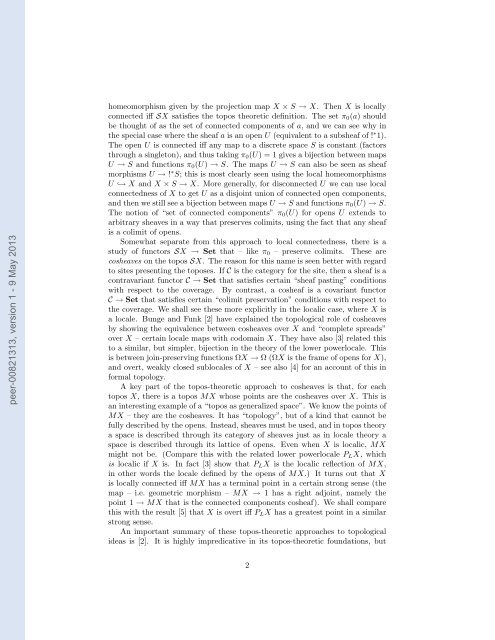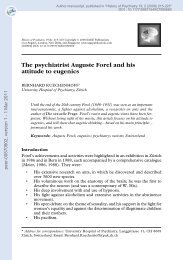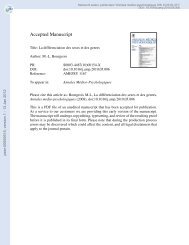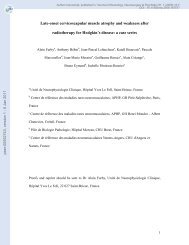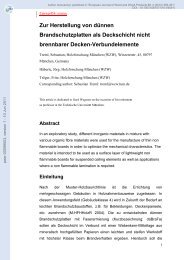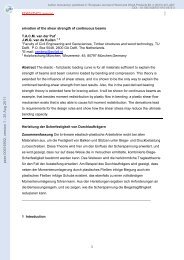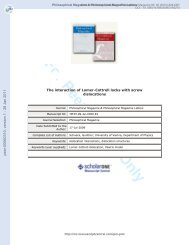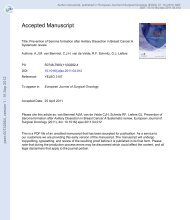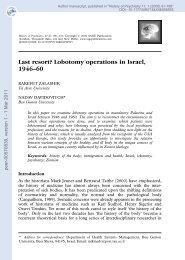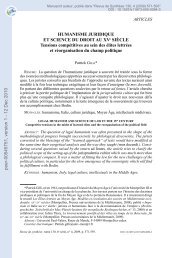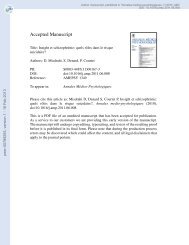Cosheaves and connectedness in formal topology
Cosheaves and connectedness in formal topology
Cosheaves and connectedness in formal topology
You also want an ePaper? Increase the reach of your titles
YUMPU automatically turns print PDFs into web optimized ePapers that Google loves.
peer-00821313, version 1 - 9 May 2013<br />
homeomorphism given by the projection map X × S → X. Then X is locally<br />
connected iff SX satisfies the topos theoretic def<strong>in</strong>ition. The set π 0 (a) should<br />
be thought of as the set of connected components of a, <strong>and</strong> we can see why <strong>in</strong><br />
the special case where the sheaf a is an open U (equivalent to a subsheaf of ! ∗ 1).<br />
The open U is connected iff any map to a discrete space S is constant (factors<br />
through a s<strong>in</strong>gleton), <strong>and</strong> thus tak<strong>in</strong>g π 0 (U) = 1 gives a bijection between maps<br />
U → S <strong>and</strong> functions π 0 (U) → S. The maps U → S can also be seen as sheaf<br />
morphisms U → ! ∗ S; this is most clearly seen us<strong>in</strong>g the local homeomorphisms<br />
U ↩→ X <strong>and</strong> X × S → X. More generally, for disconnected U we can use local<br />
<strong>connectedness</strong> of X to get U as a disjo<strong>in</strong>t union of connected open components,<br />
<strong>and</strong> then we still see a bijection between maps U → S <strong>and</strong> functions π 0 (U) → S.<br />
The notion of “set of connected components” π 0 (U) for opens U extends to<br />
arbitrary sheaves <strong>in</strong> a way that preserves colimits, us<strong>in</strong>g the fact that any sheaf<br />
is a colimit of opens.<br />
Somewhat separate from this approach to local <strong>connectedness</strong>, there is a<br />
study of functors SX → Set that – like π 0 – preserve colimits. These are<br />
cosheaves on the topos SX. The reason for this name is seen better with regard<br />
to sites present<strong>in</strong>g the toposes. If C is the category for the site, then a sheaf is a<br />
contravariant functor C → Set that satisfies certa<strong>in</strong> “sheaf past<strong>in</strong>g” conditions<br />
with respect to the coverage. By contrast, a cosheaf is a covariant functor<br />
C → Set that satisfies certa<strong>in</strong> “colimit preservation” conditions with respect to<br />
the coverage. We shall see these more explicitly <strong>in</strong> the localic case, where X is<br />
a locale. Bunge <strong>and</strong> Funk [2] have expla<strong>in</strong>ed the topological role of cosheaves<br />
by show<strong>in</strong>g the equivalence between cosheaves over X <strong>and</strong> “complete spreads”<br />
over X – certa<strong>in</strong> locale maps with codoma<strong>in</strong> X. They have also [3] related this<br />
to a similar, but simpler, bijection <strong>in</strong> the theory of the lower powerlocale. This<br />
is between jo<strong>in</strong>-preserv<strong>in</strong>g functions ΩX → Ω (ΩX is the frame of opens for X),<br />
<strong>and</strong> overt, weakly closed sublocales of X – see also [4] for an account of this <strong>in</strong><br />
<strong>formal</strong> <strong>topology</strong>.<br />
A key part of the topos-theoretic approach to cosheaves is that, for each<br />
topos X, there is a topos MX whose po<strong>in</strong>ts are the cosheaves over X. This is<br />
an <strong>in</strong>terest<strong>in</strong>g example of a “topos as generalized space”. We know the po<strong>in</strong>ts of<br />
MX – they are the cosheaves. It has “<strong>topology</strong>”, but of a k<strong>in</strong>d that cannot be<br />
fully described by the opens. Instead, sheaves must be used, <strong>and</strong> <strong>in</strong> topos theory<br />
a space is described through its category of sheaves just as <strong>in</strong> locale theory a<br />
space is described through its lattice of opens. Even when X is localic, MX<br />
might not be. (Compare this with the related lower powerlocale P L X, which<br />
is localic if X is. In fact [3] show that P L X is the localic reflection of MX,<br />
<strong>in</strong> other words the locale def<strong>in</strong>ed by the opens of MX.) It turns out that X<br />
is locally connected iff MX has a term<strong>in</strong>al po<strong>in</strong>t <strong>in</strong> a certa<strong>in</strong> strong sense (the<br />
map – i.e. geometric morphism – MX → 1 has a right adjo<strong>in</strong>t, namely the<br />
po<strong>in</strong>t 1 → MX that is the connected components cosheaf). We shall compare<br />
this with the result [5] that X is overt iff P L X has a greatest po<strong>in</strong>t <strong>in</strong> a similar<br />
strong sense.<br />
An important summary of these topos-theoretic approaches to topological<br />
ideas is [2]. It is highly impredicative <strong>in</strong> its topos-theoretic foundations, but<br />
2


